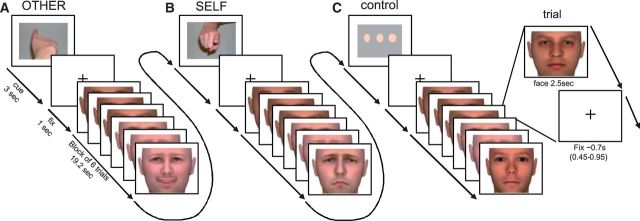Fig. 1.

Time course of stimulus presentation during the scanning session. Subjects were instructed to empathize with the person presented on the screen and to (A) identify the emotional state (happy, neutral and sad) observed in the face (other-task) or (B) evaluate their own emotional response (happy, neutral and sad) to that face (self-task). As a control-task (C) a perceptual decision on the width of neutral faces (slim, normal wide) was used. Each block (19.2 s) was preceded by an instruction cue (3 s) and comprised six stimulus faces (each 2.5 s), separated by a fixation cross (jittered duration: 0.45–0.95 s). Instruction cues were pictures of a finger pointing towards the subject (self-task), pointing away from the subject (other-task) or three dots of increasing width (control-task). Each of n = 72 individual faces was presented once displaying a happy expression, once displaying a sad expression and once displaying a neutral expression. Faces had either a low or high intensity emotional expression. Tasks varied block-wise with 6 trials per block, resulting in 32 blocks and 192 trials overall. Prior to scanning, subjects were trained on the experimental tasks. Reprinted with permission from Schulte-Rüther, M., et al. (2011). Dysfunction in brain networks supporting empathy: an fMRI study in adults with autism spectrum disorders. Social Neuroscience, 6(1), 1-21, Copyright 2010 Taylor & Francis Ltd. (http://www.tandfonline.com/doi/full/10.1080/17470911003708032)
